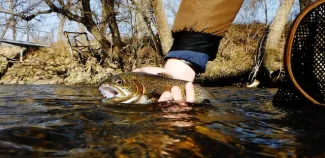
Trout are not native to Oklahoma. Before 1958, anglers did not have the privilege of fishing for trout in the state. But that year, the Oklahoma Department of Wildlife Conservation decided to increase angler opportunity and fishing diversity by stocking trout in the Illinois River below the Lake Tenkiller dam, where the water was cold enough to allow trout to survive.
In the 63 years since those first trout were introduced to Oklahoma, the Department’s trout stocking program has grown in every way imaginable, including cost.
Now, rainbow and brown trout are stocked year-round at two designated trout fishing areas: the Lower Illinois River and the Lower Mountain Fork River below Broken Bow Reservoir. At other seasonal sites across the state, rainbow trout are stocked during the winter months.
In order to continue providing a quality trout fishing experience, the Wildlife Department has reduced the statewide harvest limit for trout for the first time in the program’s history. While anglers are permitted to catch and release as many trout as they wish, starting Sept. 11, 2021, anglers are allowed to harvest three trout per day instead of six in all areas. There are additional special regulations for the Blue, Lower Illinois and Lower Mountain Fork rivers.
The reasons for this statewide daily limit adjustment fall into these broad categories:
- Quality of fishing experience.
- Strategic planning goals.
- Regulations and license simplification.
The Wildlife Department recognizes that Oklahoma’s trout fisheries are popular and important resources for many resident and nonresident anglers. The two year-round trout sites and the seasonal put-and-take fisheries provide additional fishing opportunities to anglers in Oklahoma during the winter months when state waters are cold and native fish species are less active.
In most state waters, trout can only survive about six months of the year; then the water becomes too warm for them to survive. However, trout can survive year-round in the Lower Mountain Fork and Lower Illinois rivers.
THE EXPERIENCE
Many trout anglers put a great deal of focus on harvesting trout. While harvest is an important part of all types of fishing, it shouldn’t be the only focus when fishing for trout in Oklahoma.
Surveys show that most people who go fishing most enjoy the time away from the everyday grind and the relaxation they can get being outdoors. Many trout areas offer beautiful views of nature, a chance for solitude, and an opportunity to catch fish. For some, spending quality time outdoors with friends or family is most important, and the chance to catch a trout or two is an enjoyable bonus.
Trout truly are “bonus fish” in Oklahoma, a non-native species that offers angling action during the winter months when most native species are less active.
By reducing the daily limit to three, more trout will remain in the water for a longer time, keeping trout densities at a level that still provides a quality fishing experience to more anglers. The lower daily limit should allow more anglers to catch a limit more often or faster than before.
Additionally, more anglers may be able to cycle through trout fishing “hot spots” in a trout fishing area because anglers are likely to catch a limit faster and vacate that site, allowing different anglers a chance to fish in that spot.
While the Wildlife Department encourages the harvest and consumption of fish when desired, it was never the Department’s goal to provide trout as a primary food resource. Naturally reproducing species with large populations and liberal bag limits, such as crappie, white bass, or catfish, are species that can provide the level of harvest needed to serve as a significant food resource. ODWC does not have the resources to stock enough trout to allow harvest at similar levels to these native and naturally reproducing species.
The recent angler survey also asked current trout anglers how a daily limit reduction to three trout would affect their fishing. Overall, anglers reported that a reduction to three fish would not affect their trout fishing experience.
STRATEGIC PLANNING GOALS
Goal 3 of the Department’s Strategic Plan adopted in 2019 is to “manage money and services to our fullest potential to ensure financial responsibility and sustainability.” As such, the Fisheries Division is critically evaluating the trout program and how the money is spent. To that end, the Fisheries Division has implemented a self-imposed spending cap at the current level.
The costs for catchable-size hatchery trout and transportation to Oklahoma have risen exponentially since 1997. During the same time, license prices have stayed constant.
All the trout stocked into Oklahoma waters are shipped by truck from out of state to Oklahoma’s designated trout areas. Oklahoma does not have any cold-water trout hatcheries, unlike its neighbors in Missouri, Arkansas, Colorado, and New Mexico.
The three-fish daily limit will reduce the harvest for each individual angler and spread out harvest among anglers and time during the trout season.
REGULATIONS AND LICENSE SIMPLIFICATION
Adopting a three-trout daily limit statewide brings all of the Department’s trout areas in line with the daily limit currently in effect on most of the Lower Mountain Fork River, where the limit was reduced to three trout during the 2020 rule-making cycle. Area fisheries managers report that anglers on the Lower Mountain Fork have adapted well to the reduced harvest limit there.
The number of three fish was not arbitrarily picked. Fisheries managers believe a three-trout limit is a sustainable number now and into the future. The three-trout limit is also consistent with a new aggregate limit of three fish at all statewide Close to Home Fishing areas, at least two of which are designated seasonal trout fisheries.
In summary, the Wildlife Department’s decision to reduce the statewide trout daily harvest limit to three fish is one of the first steps to better manage the state’s Trout Stocking Program. The Department will continue to evaluate all aspects of the program to make trout stocking sustainable for many years into the future.